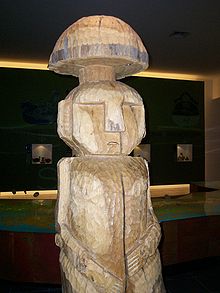Chemamull
- Chemamull
-

Un chemamull exposé au musée chilien des arts précolombiens à Santiago du Chili
Un chemamull (chemamüll ou chemamul) qui signifie « personnage en bois » en mapudungun (par l'association de che, personnage et mamüll, bois), est une statue en bois sculptée et utilisée par les Amérindiens mapuches lors de rites funéraires[1].
Le chemamüll est taillé dans des troncs ou des morceaux d'arbres. Ces statues peuvent faire plus de 2 mètres de haut, et représentent le corps et la tête stylisés d'un être humain.
Notes et références
Voir aussi
Articles connexes
Liens externes
Wikimedia Foundation.
2010.
Contenu soumis à la licence CC-BY-SA. Source : Article Chemamull de Wikipédia en français (auteurs)
Regardez d'autres dictionnaires:
Chemamull — Este artículo o sección necesita referencias que aparezcan en una publicación acreditada, como revistas especializadas, monografías, prensa diaria o páginas de Internet fidedignas. Puedes añadirlas así o avisar … Wikipedia Español
Chemamull — Wooden statues or chemamüll Chemamüll (“people wood,” from Mapudungun che “people” and mamüll “wood”) are Mapuche statues made of wood used to signal the grave of a deceased person. Description The chemamüll are carved wooden statues, usually… … Wikipedia
Mapuches — «Araucano» redirige aquí. Para otras acepciones, véase Arauca. Mapuches Matrimonio mapuche circa 1890. Ubi … Wikipedia Español
Mapuche religion — The beliefs of the Mapuche and their mythology, stories about to the world and creatures born of the extensive and old religious beliefs, next to a series of common legend and myths that belong to the different groups that compose the Mapuche… … Wikipedia
Mapuche — Mapuche … Wikipedia
Colocolo (tribal chief) — Colocolo statue, in Estadio Monumental, Santiago de Chile. Colocolo (from Mapudungun colocolo , mountain cat) was a Mapuche leader ( cacique lonco ) in the early period of the Arauco War. He was a major figure in Alonso de Ercilla y Zúñiga s epic … Wikipedia
Michimalonco — Michima Lonco (fl. mid 16th century) (michima means foreigner and lonco means head or chief in Mapudungun language) was an indigenous chief said to be a great warrior, born in the Aconcagua Valley and educated in Cusco by the Inca… … Wikipedia
Conquest of the Desert — Conquest of the Desert, by Juan Manuel Blanes (fragment showing Julio Argentino Roca, at the front) The Conquest of the Desert (Spanish: Conquista del desierto) was a military campaign directed mainly by General Julio Argentino Roca in the 1870s … Wikipedia
Mapuche mythology — The beliefs of the Mapuche and their mythology, stories about to the world and creatures born of the extensive and old religious beliefs, next to a series of common legend and myths that belong to the different groups that compose the Mapuche… … Wikipedia
Malón — redirects here. For the Spanish town, see Malon, Zaragoza. El Malón, Johann Moritz Rugendas (1802 1858) … Wikipedia

